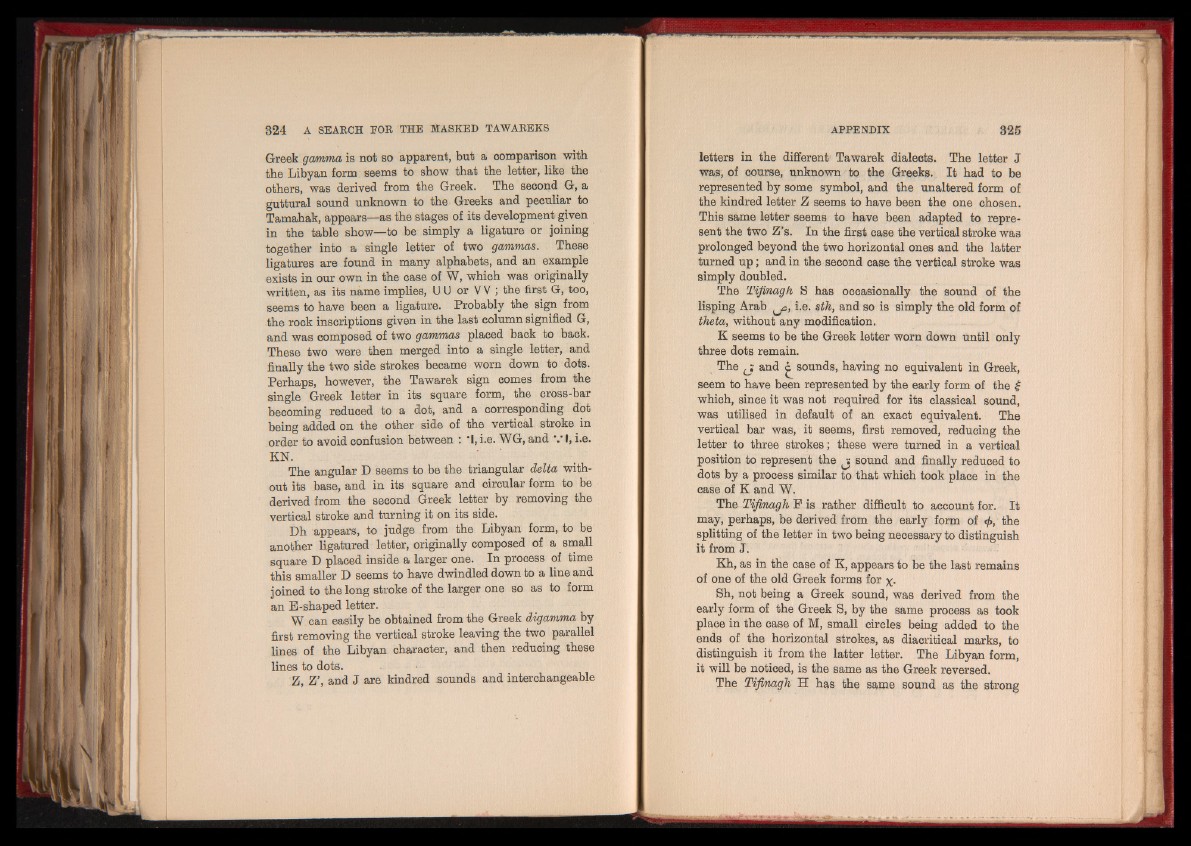
Greek gemma is not so apparent, but a comparison with
the Libyan form seems to show that the letter, like the
others, was derived from the Greek. The second G, a
guttural sound unknown to the Greeks and peculiar to
Tamahak, appears—as the stages of its development given
in the table show—to be simply a ligature or joining
together into a single letter of two gammas. These
ligatures are found in many alphabets, and an example
exists in our own in the case of W, which was originally
written, as its name implies, UU or W ; the first G, too,
seems to have been a ligature. Probably the sign from
the rock inscriptions given in the last column signified G,
and was composed of two gammas placed back to back.
These two were then merged into a single letter, and
finally the two side strokes became worn down to dots.
Perhaps, however, the Tawarek sign comes from the
single Greek letter in its square form, the cross-bar
becoming reduced to a dot, and a corresponding dot
being added on the other side of the vertical stroke in
order to avoid confusion between : 'I, i.e. WG, and VI, i.e.
KN. The g.r.gnla,r D seems to be the triangular delta without
its base, and in its square and circular form to be
derived from the second Greek letter by removing the
vertical stroke and turning it on its side.
Dh appears, to judge from the Libyan form, to be
another ligatured letter, originally composed of a small
square D placed inside a larger one. In process of time
this smaller D seems to have dwindled down to a line and
joined to the long stroke of the larger one so as to form
an E-shaped letter.
W can easily be obtained from the Greek digamma by
first removing the vertical stroke leaving the two parallel
lines of the Libyan character, and then reducing these
lines to dots. •
Z, Z’, and J are kindred sounds and interchangeable
letters in the different Tawarek dialects. The letter J
was, of course, unknown to the Greeks. It had to be
represented by some symbol, and the unaltered form of
the kindred letter Z seems to have been the one chosen.
This same letter seems to have been adapted to represent
the two Z’s. In the first ease the vertical stroke was
prolonged beyond the two horizontal ones and the latter
turned up; and in the second case the vertical stroke was
simply doubled.
The Tifinagh S has occasionally the sound of the
lisping Arab (yS, i.e. sth, and so is simply the old form of
theta, without any modification.
K seems to be the Greek letter worn down until only
three dots remain.
The and c sounds, having no equivalent in Greek,
seem to have been represented by the early form of the £
which, since it was not required for its classical sound,
was utilised in default of an exact equivalent. The
vertical bar was, it seems, first removed, reducing the
letter to three strokes; these were turned in a vertical
position to represent the j sound and finally reduced to
dots by a process similar to that which took place in the
case of K and W.
The Tifinagh E is rather difficult to account for. It
may, perhaps, be derived from the early form of <f>, the
splitting of the letter in two being necessary to distinguish
it from J.
Kh, as in the case of K, appears to be the last remains
of one of the old Greek forms for x-
Sh, not being a Greek sound, was derived from the
early form of the Greek S, by the same process as took
place in the case of M, small circles being added to the
ends of the horizontal strokes, as diacritical marks, to
distinguish it from the latter letter. The Libyan form,
it will be noticed, is the same as the Greek reversed.
The Tifinagh H has the same sound as the strong